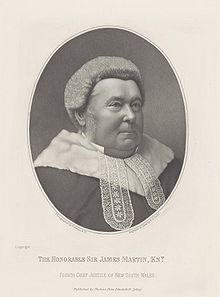James Martin (Australian politician)
|
The Honourable Sir James Martin KCB, QC |
|
|---|---|
 |
|
| 6th Premier of New South Wales | |
|
In office 16 October 1863 – 2 February 1865 |
|
| Preceded by | Charles Cowper |
| Succeeded by | Charles Cowper |
| Constituency |
Tumut (until 1864) Monaro |
|
In office 22 January 1866 – 26 October 1868 |
|
| Preceded by | Charles Cowper |
| Succeeded by | John Robertson |
| Constituency | Lachlan |
|
In office 16 December 1870 – 13 May 1872 |
|
| Preceded by | Charles Cowper |
| Succeeded by | Henry Parkes |
| Personal details | |
| Born |
14 May 1820 Midleton, Co. Cork, Ireland, UK |
| Died | 4 November 1886 (aged 66) Potts Point, New South Wales |
| Resting place | Waverley Cemetery |
| Nationality | British |
Sir James Martin, KCB, QC (14 May 1820 – 4 November 1886) was three times Premier of New South Wales, and Chief Justice of the Supreme Court of New South Wales from 1873 to 1886.
Martin was born in Midleton, County Cork, Ireland but emigrated with his parents to Sydney, Australia at the age of one. He was educated at Dame's School, Parramatta and, despite his family's poverty, the Sydney Academy and Sydney College under the tutelage of William Timothy Cape, and left school at the age of 16 to become a reporter.
In 1838, Martin published the Australian Sketch Book, a series of character sketches he dedicated to Sydney barrister George Robert Nichols, for whom he was then working as an articled clerk in 1840.
Martin qualified as a solicitor in 1845, and combined his legal career with employment as a newspaper editor and publisher. He married Isabella Long on 20 January 1853 and together they produced 15 children.
In 1848 Martin stood for the electorate of Durham in the New South Wales Legislative Council, but withdrew before polling day. Later in the same year he was unopposed in a by-election for the electorate of Cook and Westmoreland.
Martin was an effective legislator but his sharp tongue and intemperate speeches to the House made him few friends among his parliamentary colleagues. His most notable political achievement in his first eight years in office was to initiate the Parliamentary debate that led to the establishment of a branch of the royal mint in Sydney.
...
Wikipedia
